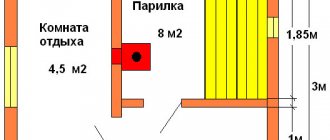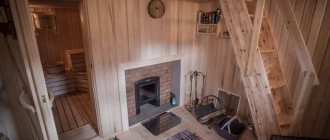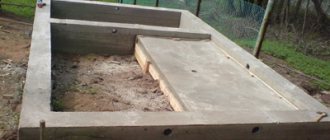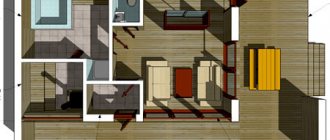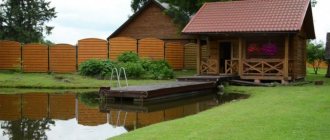For the most part, owners of country plots set up a bathhouse on their property, it doesn’t matter if it’s a permanent home or a summer house.
Traditional construction requires wastewater disposal. Of course, you can buy a ready-made system, but the designs are expensive. There is always a solution - to make a septic tank for a bathhouse with your own hands.
The first thing to decide is whether the building will be equipped with a toilet.
Drains from a bathhouse without a toilet contain epidermis, soapy water, a little grease and leaves from brooms. This allows the installation of any system without pumping. The presence of a latrine in a building changes the nature of the water; therefore, not every septic tank can cope with sewage waste.
What is a septic tank for a bathhouse
It is first necessary to clarify that the septic tank can be single-chamber or double-chamber. The first type is considered a simple and affordable design option. It is organized at the initial stages of foundation construction.
It is recommended to use such a pit in places where there is no bathroom. In addition, the area of the room should not be too large.
During the construction stages, a volumetric pit is dug, which should be located below the foundation.
- Its sealing deserves special attention.
- A layer of sand mixed with fine gravel is poured into the recess.
- The layer thickness should be approximately 70 cm.
- The floor coverings in the bathhouse are formed in such a way that the liquid can move freely under it to the area of the drainage pit.
Here the liquid will settle using the drainage system. Natural filters ensure uniform removal of contaminated liquid into deep layers of soil.
Nuances of selection and installation
To correctly select and install a septic tank, you need to follow several rules.
Septic tank volume
It is worth making simple calculations on the amount of wastewater from the bathhouse.
Example. 6 people take a bath at a time. On average, everyone uses 50 liters of water
6*50=300l
The septic tank must have a volume of at least 400 liters. Taking into account that no one will go to the bathhouse next. If it is designed for several visits in a row, then the volume triples.
If the bathhouse is equipped with a font
When choosing the volume of a septic tank, you should take into account the drainage of the container.
Bathhouse with or without toilet. The bathroom in the bathhouse - a two-chamber septic tank is definitely installed.- The septic tank is installed at a distance of 3-5 meters from the bathhouse.
- The slope of pipes and sewer and connecting sections is always maintained at 2-3 cm per meter. This is necessary to create gravity flow. Otherwise, the system will become clogged or a pump will have to be installed.
- The two-section septic tank must have free access for sewage disposal equipment. Service equipment hose 6-15 meters.
- The cleaning system is always set up according to the slope of the terrain. Sump at a high point, drainage well towards the bottom.
- Sewer pipes should be insulated, which will help avoid freezing during the cold season. Or lay them below the soil freezing level.
Construction of a septic tank made of automobile rubber
Not far from the bathhouse building, a pit is dug, the depth of which reaches 3.5 m. The diameter of such a pit should be 25 cm larger than the diameter of the rubber tires. A layer of natural filter is placed at the bottom of the recess.
Rubber tires are cut into 2 parts. Thus they fit tightly to each other. Connections must be sealed.
In the area of the upper tire, holes are made to fix the pipe. It will subsequently be connected to the sewer pipes. The finished structure must be covered with an iron sheet. The remaining area in the pit is covered with soil and gravel. The result is a complete septic tank.
However, this design has several disadvantages. They are as follows:
- Minimum service life;
- Lack of quality cleaning capabilities;
- Insufficient level of sealing.
As for the advantages, they are as follows:
- Minimum financial investment;
- Simple and quick installation;
- Do not require regular;
- When the septic tank is completely filled, it must be filled with soil and a new structure created.
Manufacturing
If you have chosen the option of making your own septic tank, you need to study the stages of the work. It is recommended to draw up a drawing of the future design in advance, prepare consumables and tools.
Preparation and design
To correctly position the vertical drain channel, you need to draw a drawing of the entire area. It should indicate the distance to each object, building, large tree. Choose a place.
Using shovels, dig a pit for the septic tank. The greater its depth, the better. When choosing the depth, you need to take into account the height of the groundwater.
Tools and materials
To carry out the work you should prepare:
- concrete mixer, boards, slats;
- screwdriver, hammer, nail puller;
- building level;
- fittings, two metal hatches;
- bayonet, shovel;
- buckets, bricks.
Additionally you will need cement, sand, gravel.
Formwork
Before you start mixing the cement mortar, you need to assemble the wooden formwork into which it will be poured. Execution of work:
To increase the reliability of the formwork, it is recommended to secure reinforcement between the wooden panels.
Pouring concrete
After assembling the formwork, you can begin mixing the cement mortar. To do this you need to mix 3 components:
- 2 parts gravel;
- 1 part cement;
- 2 parts sand.
When the mixture is ready, add a small amount of water to it and mix thoroughly. The solution is poured at once or in several stages. The second option is relevant for those situations when the depth of the septic tank is large, and there is not enough formwork to the very top.
Overlap
When the main frame of the septic tank hardens, you need to make an upper floor with hatches. To do this, you need to perform several steps:
All that remains is to install the hatches on both holes in the ceiling and wait for the cement mortar to dry. When the homemade septic tank is ready, you can fill the structure with earth. It is necessary to leave two hatches for free access.
Creating a septic tank for a bathhouse from concrete rings
Before starting the installation of such a structure, you will need to use reinforced concrete rings, the height of which reaches up to 1 m, and the diameter is around 1.20 m.
Reinforced concrete structures are produced with connecting elements that facilitate installation. Installation is carried out using the tire well method.
It is first necessary to organize a deep pit.
- Rings will be lowered into it. The number of elements directly depends on the depth of the pit.
- The seams between the parts must be carefully sealed.
- This part is decorated with a natural filter made from a mixture of sand and fine gravel.
- After this, the pipe is removed to allow unhindered drainage of dirty water. The entire structure is covered with a lid.
- It is also provided by manufacturers complete with reinforced concrete rings. The surface of the septic tank is covered with soil.
The advantage of a design using reinforced concrete rings is the reliability of the material.
The metal reinforcement inside such rings is capable of stopping the deformation of the surface of the product under conditions of low temperature and increased load.
Ready-made models
If you don’t have time to worry about how to make a septic tank for a bathhouse with your own hands, it makes sense to purchase practical and functional devices at an affordable price. Popular models:
| Model name | Characteristics | Price range |
| Septic tank “Triton” Mini – 750 l/Micro – 450 l | Double-chamber/single-chamber. Light weight – 70/40 kg. Withstands temperatures down to -30 ⁰С. Equipped with a post-treatment system. | The cost of the kit with infiltrator, lid, neck is about 21,000/12,000 rubles. |
| DKS 15 and 15M | Capacity – 450 liters per day. Autonomous, easy to maintain. | About 29,000-33,500 rubles. |
In addition, there are a large number of deep cleaning stations such as “Topas”, “Unilos”, etc., the price of which will be much higher. However, the optimal solution for a bathhouse is simple installations with mechanical filters and sedimentation tanks, which, if necessary, can be equipped with a soil purification system.
Septic tank for a bathhouse made of a plastic barrel
This design is a single-chamber septic tank model. To create such a design, you will need a container with a volume of 250 liters. It is necessary to drill small holes on the surface, which should be located at the same distance.
- After this, you need to dig a deep hole. Its size must be at least 85 cm in depth and 65 cm in diameter. A pipe must be mounted in the lower part.
- The main requirement is to create a high-quality seal in the area of connection between the pipe and the plastic barrel.
The bottom of the hole must be filled with a mixture of sand and gravel. The drainage layer must be thoroughly compacted, and then thoroughly spilled with liquid. After this, another layer of river sand, fine gravel or crushed stone is applied.
It is necessary to install a plastic barrel on the compacted bottom, on top of which a pipe is installed. After this, the surfaces of the product are carefully wrapped in a layer of geofabric. This will prevent clogging of through holes. After this, the sewer pipes are connected, and the surface of the product is covered with a layer of soil.
Main types of drain pits
Construction of any drainage pit is a rather labor-intensive process, since the pit will most likely have to be dug manually. At the same time, such a hydraulic structure is not very complex in design, so any owner of the site can build and equip it independently, without even involving assistants, of course, if there is enough strength for excavation work.
Drainage pits can be divided into three main types - a sealed container, a pit with drainage capacity, and a septic tank consisting of several chambers.
First, let’s figure out what each of the varieties is, in principle.
- A sealed drainage pit is most often installed on construction sites with shallow groundwater aquifers. It is more often called a cesspool, that is, requiring periodic emptying of accumulated volumes of dirty water.
To build it, a pit is dug into which a container with a sufficiently large volume is installed. This is where wastewater will be collected. As the container is filled to a certain critical level, the waste is pumped out by a sewage disposal machine.
If you have a cesspool completely isolated from the external environment, you will have to very often use the services of sewerage equipment
This option is environmentally friendly, since no contaminants or chemical cleaning solutions get into the soil and groundwater, which can negatively affect the condition of the fertile soil on the site, as well as have a negative impact on high-lying ground aquifers. However, this option is not convenient and economical, since you will have to constantly monitor the filling level of the container and often call specialized vehicles, and such services are not cheap.
Prices for septic tanks
septic tank
- There is no hermetically sealed bottom created in the drainage drainage pit. It is used as a bulk layer of filtering building material - most often crushed stone or gravel is chosen for this purpose.
The bottom of the drainage pit is covered with a layer of filter material - crushed stone or gravel.
In addition, holes are often made in the walls of the drainage pit at a certain height through which water will be absorbed into the soil. This option is perfect for a bathhouse and is perhaps the easiest to build, however, if the soil characteristics on the site allow it.
- A septic tank is a whole system consisting of two or more chambers that have different purposes.
In any of the options, the first chamber most often has a sealed design and is used for collecting, primary filtration and purification of waste - solid components settle to the bottom, and liquid components are clarified and undergo a biological treatment cycle due to the action of aerobic microorganisms. This container is connected to the second chamber with a special overflow pipe - clarified liquid waste flows into the next compartment, which is already organized according to the principle of a drainage well. Water passes through the drainage, is further purified and absorbed into the soil.
Approximate diagram of a simple septic tank
If a septic tank of three containers is planned, then the third chamber is made into a drainage chamber. The second serves for the final sedimentation of suspensions, deeper purification of water due to the action of anaerobic microorganisms. And from here the purified liquid is poured into the drainage well.
A septic tank is most often installed when it is expected to collect the entire considerable volume of liquid waste from both a residential building and a bathhouse.
What is important to know about the design and rules of septic tank equipment?
A septic tank is already a rather complex engineering structure, the creation of which must obey certain rules. Often, home owners prefer to install a ready-made factory-produced system. What are the rules for arranging such a treatment plant, and what to pay special attention to when choosing a septic tank - read in the special publication of our portal.
How to make a septic tank from plastic rings
This model of septic tank can be installed using the construction method of concrete rings. The main difference is simpler installation. It is worth noting that such septic tank models are designed for arranging a bathhouse that does not have a bathroom.
- For work, plastic rings are used, which are installed on top of each other.
- The joints are tightly sealed to prevent spontaneous leakage of sewer fluid.
- The bottom of the pit is covered with a thick layer of natural filter.
To quickly clean the liquid, it is recommended to use coarse river sand and a layer of fine gravel. In this way, sewage will quickly get rid of organic impurities.
What volume is needed?
So, in order to decide what size to build a septic tank, you should calculate the volume of wastewater per day. It is important to take them into account threefold. Therefore, the volume of the structure can be calculated according to the standard scheme (for example, for 3 people). For example, the volume of wastewater is 100 l/day, provided that all three people use the bathhouse. This number is multiplied by 3 to get 300 liters. This is 0.3 m3. At the same time, for complete purification, the water must remain in the septic tank for at least 14 days. Then 0.3 is multiplied by 14, resulting in 4.2 m3. Since the bathhouse is not used every day, such volumes will not be built up soon. Therefore, the septic tank can have smaller dimensions.
Septic tank volume calculator
Photo of the correct septic tank for a bath
Briefly about the main thing
If the volume of sewage from a private or country house does not exceed 1 cubic meter per day and is less than the capacity of the drain tank for a single discharge, then a 200 liter barrel can be used to install a toilet. In this case, a septic tank of this kind will be single-chamber, and most of the liquid fraction from the wastewater will be filtered and absorbed by the lower layers of the soil.
Barrels for the cesspool can be made of plastic and metal, specially designed for this purpose and equipped with appropriate devices, or ordinary household ones. The main advantages of plastic specimens are durability, inertness to corrosion and aggressive environments, the disadvantage is low mechanical strength and insufficient frost resistance. The advantage of metal barrels is their high strength; the disadvantages are associated with a short service life due to susceptibility to rust.
The location for the arrangement of the drain tank must meet the following requirements:
- At least 10 meters from the house.
- Minimum 7-8 m to utility structures.
- Location on the leeward side of the house.
- To the water source - from 20 m, to the water supply - at least 10 m.
- To the fence of the site - from 1 m.
When choosing a barrel, the volume of wastewater, the nature of operation, the type of soil and the budget of the event are taken into account. The installation of the sewerage system should be carried out according to the instructions in compliance with technical rules.
Ratings 0
